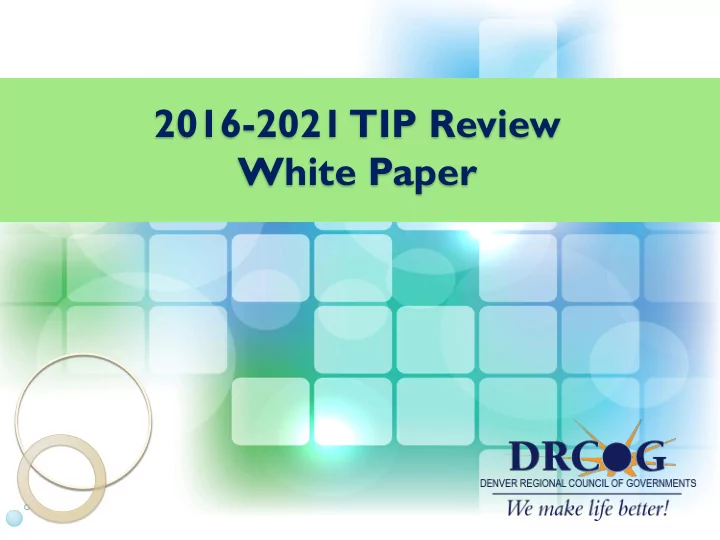

2016-2021 TIP Review White Paper
TIP Review White Paper Board Direction (August 2015 Meeting) ◦ …… to address TIP process, funding allocation and any other criteria mentioned by this Board, including looking at other MPOs around the country and bringing it back to the Committee in six months (February 2016). Staff established Work Group of TAC members ◦ 22 members ◦ Met eight times from October 16, 2015 to February 3, 2016
White Paper Table of Contents Introduction and Purpose Federal Requirements Review of the Existing TIP Process What are other MPOs doing? Key Issues Two TIP Models Recommendations Appendices
Federal Requirements for the TIP Cover no less than four years and be updated at least every four years Fiscally constrained by funding program Consistent with RTP Identify criteria and process used for prioritizing projects Consideration and implementation of projects/programs consistent with the federal planning factors Flexibility to MPOs in how it may select projects
Review of existing TIP Process Comments derived from 1. TIP Open Forum (June 2015) 2. Board comments (August 2015) 3. TIP Review Work Group Survey Summary of feedback ◦ Positive and feedback requiring further discussion
Summary of Feedback Positive: ◦ TIP training ◦ Web-based call for projects ◦ Two-phased selection process Needing further discussion: ◦ Creation of TIP policy ◦ Minimum funding request development work group ◦ Funding swap with CDOT ◦ Adequacy of project types ◦ Points for Metro Vision ◦ Eligible project components criteria ◦ Assigning a project score to ◦ Multimodal Connectivity studies points – Roadway Projects ◦ Max. number of TIP submittals ◦ Call for projects frequency
Other MPOs
Key Issues Incorporation of Metro Vision in the TIP Process ◦ How best to incorporate? ◦ Level of flexibility? Geographic Equity ◦ Does the current formula accurately reflect the primary user/benefactor of facility? ◦ Should geographic equity be a factor in project selection? ◦ Would subregional allocation of funds be more effective? ◦ What funding types (i.e. DRCOG, CDOT and RTD) should be considered in the formula?
Key Issues (cont.) Small vs. Large Communities ◦ Can small communities compete with the larger entities? ◦ Should community size be a consideration? Off-the-top program/project funding ◦ Make sure programs are beneficial ◦ Develop procedures and criteria for project selection Multimodal projects ◦ Holistic approach to project development ◦ Current project types too rigid and don’t offer the flexibility to submit projects that are truly multimodal
T wo Models Regional Model ◦ DRCOG’s current model ◦ Centralized process – all applications submitted to MPO Regional/Subregional Model (Dual Model) ◦ Seattle, Chicago ◦ Has both regional and subregional allocation elements
Model Comparison Exercise MV Incorporation ◦ Regional Model: More evenly applied in project selection Challenge: Comparing similar projects from different parts of the region ◦ Dual Model: More flexibility: Project criteria more in-tune with local values while still being consistent with MV Challenge: Meaningful oversight to make sure selection process in consistent with MV
Model Comparison Exercise (cont.) Geographic Equity ◦ Regional Model: Possible to fine- tune to better depict “users” Challenge: Still difficult to gauge true equity ◦ Dual Model: “Proportionately” allocates funding to smaller level of geography Challenge: How to distribute the funds
Model Comparison Exercise (cont.) Small vs. Large Communities ◦ Regional: Set-aside for smaller communities Challenge: Should smaller communities also be eligible for general call for projects? ◦ Dual: Competing against smaller pool of communities May encourage local partner funding opportunities Challenge: Competing for fewer dollars
Model Comparison Exercise (cont.) Off-the-top programs/projects ◦ Regional Model: Conducted before general call for project (current model) ◦ Dual Model: Could be drawn from regional allocation Multimodal Projects ◦ No clear difference
Recommendations Develop a project selection process purpose statement ◦ Develop specific goals for each TIP Further explore the Regional/Subregional dual project selection model ◦ Continue work group ◦ No fatal flaws – needs a more comprehensive evaluation
Recommendations (cont.) Create a project selection process that places more emphasis on project benefits, overall value, and return on investment ◦ Quantifiable performance metrics Explore opportunities to exchange CDOT state funds with DRCOG federal funds ◦ Create a pilot project
Recommendations (cont.) Evaluate off-the-top programs and projects ◦ Thorough review all set-aside programs ◦ Develop a clear process for the evaluation of large off-the-top project funding requests
QUESTIONS/COMMENTS
Recommend
More recommend